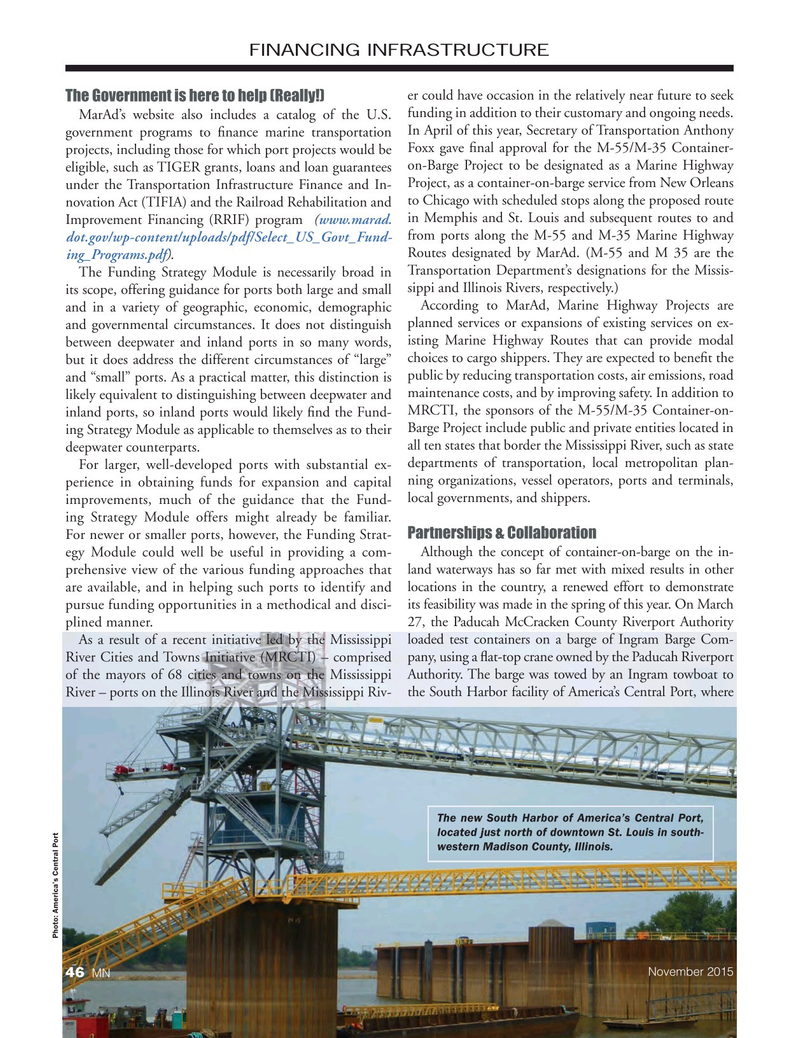
Page 46: of Marine News Magazine (November 2015)
Workboat Annual
Read this page in Pdf, Flash or Html5 edition of November 2015 Marine News Magazine
FINANCING INFRASTRUCTURE er could have occasion in the relatively near future to seek
The Government is here to help (Really!)
MarAd’s website also includes a catalog of the U.S. funding in addition to their customary and ongoing needs. government programs to ? nance marine transportation In April of this year, Secretary of Transportation Anthony projects, including those for which port projects would be Foxx gave ? nal approval for the M-55/M-35 Container- eligible, such as TIGER grants, loans and loan guarantees on-Barge Project to be designated as a Marine Highway
Project, as a container-on-barge service from New Orleans under the Transportation Infrastructure Finance and In- novation Act (TIFIA) and the Railroad Rehabilitation and to Chicago with scheduled stops along the proposed route in Memphis and St. Louis and subsequent routes to and
Improvement Financing (RRIF) program (www.marad.
from ports along the M-55 and M-35 Marine Highway dot.gov/wp-content/uploads/pdf/Select_US_Govt_Fund-
Routes designated by MarAd. (M-55 and M 35 are the ing_Programs.pdf).
The Funding Strategy Module is necessarily broad in Transportation Department’s designations for the Missis- its scope, offering guidance for ports both large and small sippi and Illinois Rivers, respectively.)
According to MarAd, Marine Highway Projects are and in a variety of geographic, economic, demographic and governmental circumstances. It does not distinguish planned services or expansions of existing services on ex- between deepwater and inland ports in so many words, isting Marine Highway Routes that can provide modal but it does address the different circumstances of “large” choices to cargo shippers. They are expected to bene? t the and “small” ports. As a practical matter, this distinction is public by reducing transportation costs, air emissions, road likely equivalent to distinguishing between deepwater and maintenance costs, and by improving safety. In addition to
MRCTI, the sponsors of the M-55/M-35 Container-on- inland ports, so inland ports would likely ? nd the Fund- ing Strategy Module as applicable to themselves as to their Barge Project include public and private entities located in all ten states that border the Mississippi River, such as state deepwater counterparts.
departments of transportation, local metropolitan plan-
For larger, well-developed ports with substantial ex- perience in obtaining funds for expansion and capital ning organizations, vessel operators, ports and terminals, local governments, and shippers.
improvements, much of the guidance that the Fund- ing Strategy Module offers might already be familiar.
Partnerships & Collaboration
For newer or smaller ports, however, the Funding Strat- egy Module could well be useful in providing a com- Although the concept of container-on-barge on the in- prehensive view of the various funding approaches that land waterways has so far met with mixed results in other are available, and in helping such ports to identify and locations in the country, a renewed effort to demonstrate pursue funding opportunities in a methodical and disci- its feasibility was made in the spring of this year. On March plined manner. 27, the Paducah McCracken County Riverport Authority
As a result of a recent initiative led by the Mississippi loaded test containers on a barge of Ingram Barge Com-
River Cities and Towns Initiative (MRCTI) – comprised pany, using a ? at-top crane owned by the Paducah Riverport of the mayors of 68 cities and towns on the Mississippi Authority. The barge was towed by an Ingram towboat to
River – ports on the Illinois River and the Mississippi Riv- the South Harbor facility of America’s Central Port, where
The new South Harbor of America’s Central Port, located just north of downtown St. Louis in south- western Madison County, Illinois.
Photo: America’s Central Port
November 2015 46 MN
MN Nov15 Layout 32-49.indd 46 10/23/2015 2:16:53 PM

 45
45

 47
47
